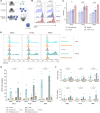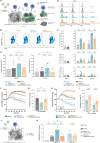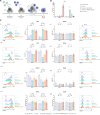A vector-encoded bispecific killer engager to harness virus-activated NK cells as anti-tumor effectors
- PMID: 36765035
- PMCID: PMC9918448
- DOI: 10.1038/s41419-023-05624-3
A vector-encoded bispecific killer engager to harness virus-activated NK cells as anti-tumor effectors
Abstract
Treatment with oncolytic measles vaccines (MV) elicits activation of immune cells, including natural killer (NK) cells. However, we found that MV-activated NK cells show only modest direct cytotoxic activity against tumor cells. To specifically direct NK cells towards tumor cells, we developed oncolytic measles vaccines encoding bispecific killer engagers (MV-BiKE) targeting CD16A on NK cells and carcinoembryonic antigen (CEA) as a model tumor antigen. MV-BiKE are only slightly attenuated compared to parental MV and mediate secretion of functional BiKE from infected tumor cells. We tested MV-BiKE activity in cocultures of colorectal or pancreatic cancer cells with primary human NK cells. MV-BiKE mediate expression of effector cytokines, degranulation and specific anti-tumor cytotoxicity by NK cells. Experiments with patient-derived pancreatic cancer cultures indicate that efficacy of MV-BiKE may vary between individual tumors with differential virus permissiveness. Remarkably, we confirmed MV-BiKE activity in primaryhuman colorectal carcinoma specimens with autochthonous tumor and NK cells.This study provides proof-of-concept for MV-BiKE as a novel immunovirotherapy to harness virus-activated NK cells as anti-tumor effectors.
© 2023. The Author(s).
Conflict of interest statement
GU acts as CMO, CSO, and COO of CanVirex, a company developing oncolytic viruses as cancer immunotherapeutics. All other authors declare no competing interests.
Figures






Similar articles
-
Bispecific killer cell engager with high affinity and specificity toward CD16a on NK cells for cancer immunotherapy.Front Immunol. 2023 Jan 6;13:1039969. doi: 10.3389/fimmu.2022.1039969. eCollection 2022. Front Immunol. 2023. PMID: 36685519 Free PMC article.
-
CD16xCD33 Bispecific Killer Cell Engager (BiKE) as potential immunotherapeutic in pediatric patients with AML and biphenotypic ALL.Cancer Immunol Immunother. 2021 Dec;70(12):3701-3708. doi: 10.1007/s00262-021-03008-0. Epub 2021 Aug 16. Cancer Immunol Immunother. 2021. PMID: 34398302 Free PMC article.
-
Targeting natural killer cells to acute myeloid leukemia in vitro with a CD16 x 33 bispecific killer cell engager and ADAM17 inhibition.Clin Cancer Res. 2013 Jul 15;19(14):3844-55. doi: 10.1158/1078-0432.CCR-13-0505. Epub 2013 May 20. Clin Cancer Res. 2013. PMID: 23690482 Free PMC article.
-
Natural Killer Cell Engagers (NKCEs): a new frontier in cancer immunotherapy.Front Immunol. 2023 Aug 9;14:1207276. doi: 10.3389/fimmu.2023.1207276. eCollection 2023. Front Immunol. 2023. PMID: 37638058 Free PMC article. Review.
-
Natural killer cells unleashed: Checkpoint receptor blockade and BiKE/TriKE utilization in NK-mediated anti-tumor immunotherapy.Semin Immunol. 2017 Jun;31:64-75. doi: 10.1016/j.smim.2017.07.011. Epub 2017 Sep 5. Semin Immunol. 2017. PMID: 28882429 Free PMC article. Review.
Cited by
-
Charting a killer course to the solid tumor: strategies to recruit and activate NK cells in the tumor microenvironment.Front Immunol. 2023 Nov 8;14:1286750. doi: 10.3389/fimmu.2023.1286750. eCollection 2023. Front Immunol. 2023. PMID: 38022679 Free PMC article. Review.
-
Viral vectored vaccines: design, development, preventive and therapeutic applications in human diseases.Signal Transduct Target Ther. 2023 Apr 7;8(1):149. doi: 10.1038/s41392-023-01408-5. Signal Transduct Target Ther. 2023. PMID: 37029123 Free PMC article. Review.
-
Measles Virus-Based Genetic Modifications: Progress in Hematological Malignancy Treatment.Onco Targets Ther. 2025 Apr 25;18:605-615. doi: 10.2147/OTT.S518407. eCollection 2025. Onco Targets Ther. 2025. PMID: 40304006 Free PMC article. Review.
-
Improved overall survival in patients with high-grade serous ovarian cancer is associated with CD16a+ immunologic neighborhoods containing NK cells, T cells and macrophages.Front Immunol. 2024 Jan 22;14:1307873. doi: 10.3389/fimmu.2023.1307873. eCollection 2023. Front Immunol. 2024. PMID: 38318505 Free PMC article.
-
Tutorial: design, production and testing of oncolytic viruses for cancer immunotherapy.Nat Protoc. 2024 Sep;19(9):2540-2570. doi: 10.1038/s41596-024-00985-1. Epub 2024 May 20. Nat Protoc. 2024. PMID: 38769145 Review.
References
-
- Harrington K, Freeman DJ, Kelly B, Harper J, Soria JC. Optimizing oncolytic virotherapy in cancer treatment. Nat Rev Drug Disco. 2019;18:689–706. - PubMed
-
- Aref S, Bailey K, Fielding A. Measles to the Rescue: A Review of Oncolytic Measles Virus. Viruses [Internet]. 2016 Oct [cited 2019 Jul 11];8. Available from: https://www.ncbi.nlm.nih.gov/pmc/articles/PMC5086626/. - PMC - PubMed
-
- Pidelaserra-Martí G, Engeland CE. Mechanisms of measles virus oncolytic immunotherapy. Cytokine Growth Factor Rev. 2020;56:28–38. - PubMed
Publication types
MeSH terms
Substances
LinkOut - more resources
Full Text Sources
Medical
Research Materials

